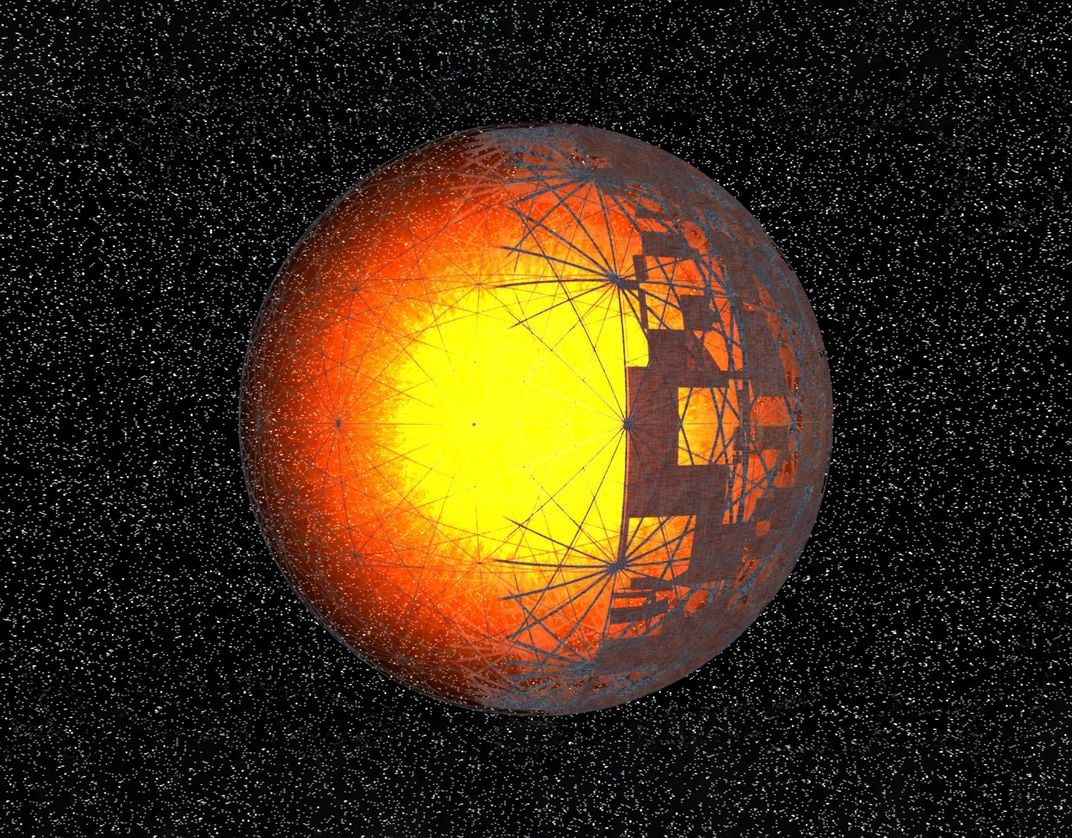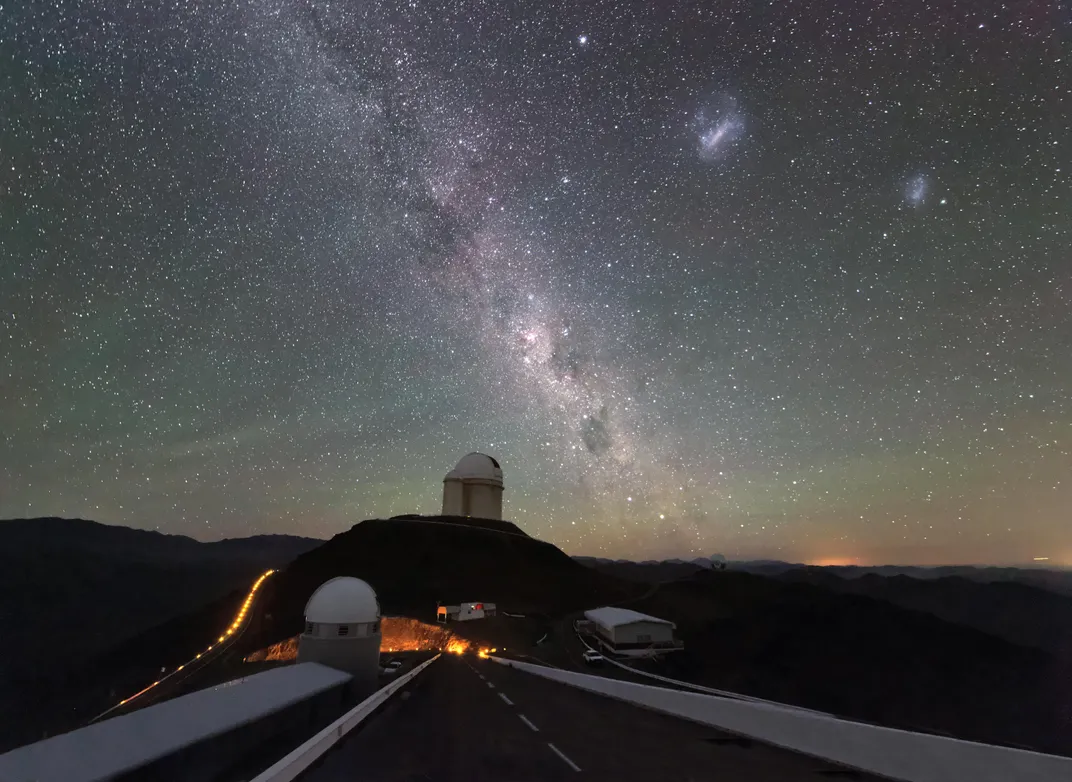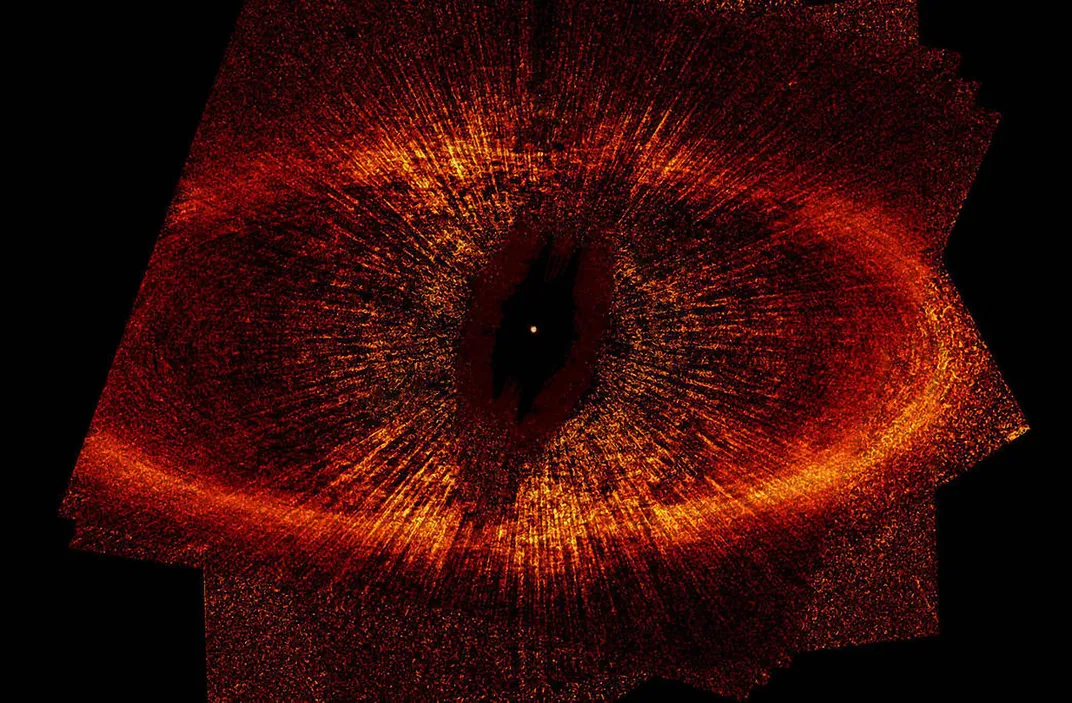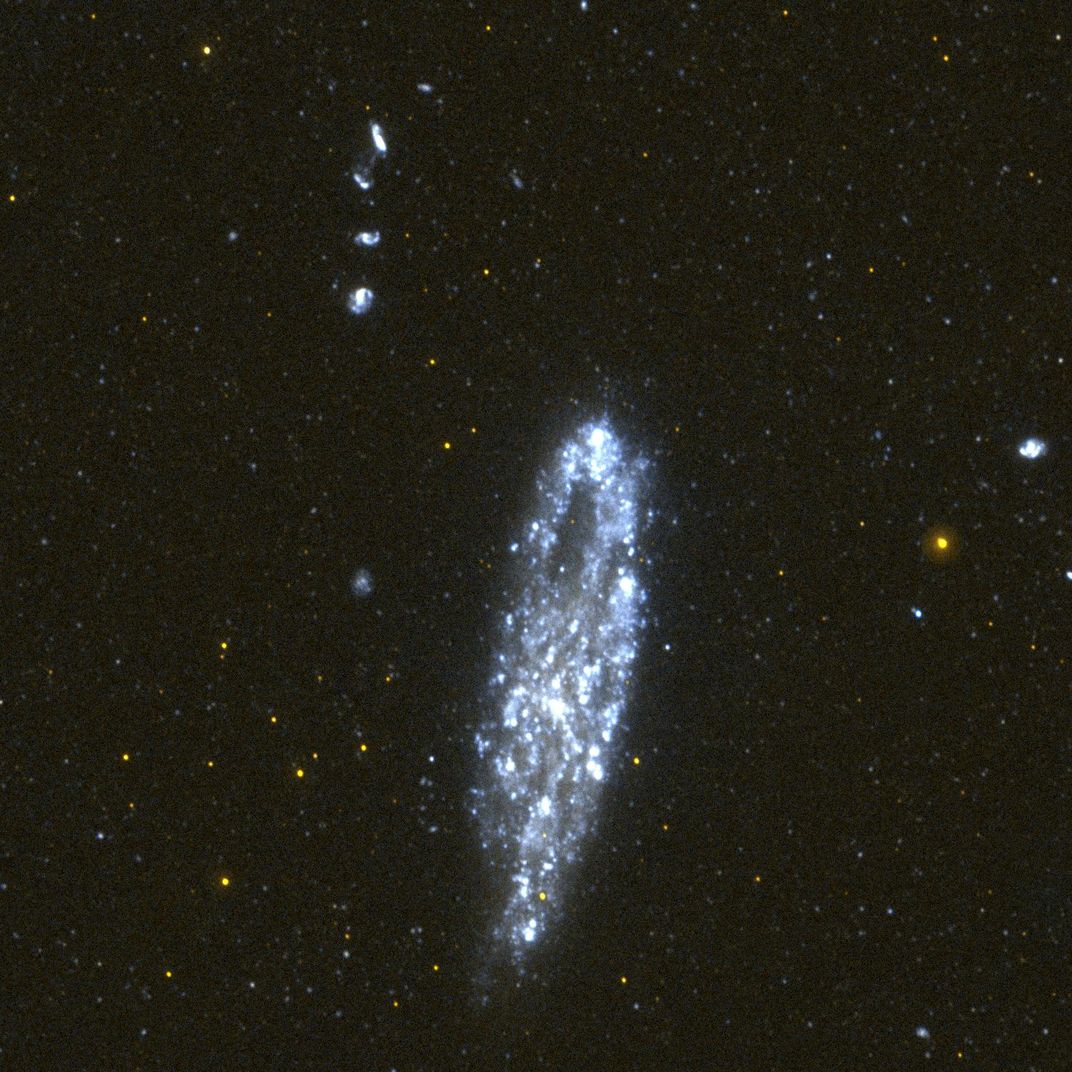The Weirdest Objects in the Universe
With a new encyclopedia, seekers for intelligent life ask astronomers to reexamine the sky.
/https://tf-cmsv2-smithsonianmag-media.s3.amazonaws.com/filer/ad/a1/ada1edef-f02b-4999-b477-997bf2c2551d/04d_dj2021_luminousinfraredgalaxynasaandromeda_live.jpg)
As long as astronomers have gazed at the stars and planets, there has been the temptation to see the handiwork of intelligent life when there is no other apparent explanation.
Babylonians believed eclipses to be omens sent by gods. Percival Lowell thought he saw canals on Mars. Aware of this history, some astronomers have found humor in it. When pulsars were discovered in the 1960s, says Seth Shostak, the senior astronomer at the SETI Institute in California, “they were first called LGMs, for ‘little green men’ by the Cambridge astronomers who found them because they didn’t know what they were. They were very regular radio sources. Within a year, the theoreticians figured out what they were”— rapidly rotating compact stars emitting radiation like lighthouses. More recently, he notes, a weirdly dimming object called Tabby’s Star inspired theories of alien life, before astronomers solved the puzzle.
But what about the many puzzles in the universe that astronomers have not yet solved? Recently, scientists engaged in the search for extraterrestrial intelligence (SETI) have suggested that it’s time to look—as well as listen—for advanced civilizations. “SETI researchers do exactly what Frank Drake did in the first SETI experiment 60 years ago,” says Shostak. A SETI founder, Drake assumed that because life developed on Earth, it would be most likely found on planets like ours orbiting stars like our sun. He and others pointed radio antennas at star systems likely to have planets and listened. Now scientists engaged in the search think it’s time for a change. “It’s worthwhile to not just do what was done 60 years ago, but also to keep an eye out for very unusual things,” says Shostak. “The universe has been around for three times as long as the Earth has been around, so there could be aliens out there that are very, very much more advanced than we are—not just 1,000 years, but millions and billions of years ahead. What could they build? Maybe they could re-engineer a star system.”
NASA recently awarded a grant to a SETI project that will seek out signs of alien “technosignatures,” such as solar panel arrays on distant exoplanets. Breakthrough Listen, the largest SETI initiative to date, is thinking even bigger, searching for sophisticated engineering projects that span entire star systems or even galaxies (see “Signs,” Feb./Mar. 2019).
“It’s a fine line,” says Andrew Siemion, director of the Berkeley SETI Research Center and the principal investigator of Breakthrough Listen. “We have no evidence for technologically capable life anywhere else in the universe. So one doesn’t want to immediately leap to that solution for any newly discovered astronomical phenomenon. But at the same time, one doesn’t want to neglect the possibility that it could be going on.”
Earlier this year, to help locate possible targets for future searches—whether for signals or artifacts—Breakthrough Listen released the first cut of its Exotica Catalog, a listing of almost 800 astronomical objects. Most of the catalog is a “one-of-everything” compilation, from rocky planets to blue-straggler stars. A smaller section lists the superlatives: the biggest, the hottest, the brightest, the farthest. But the most intriguing section catalogs anomalies: strange, unexplained objects such as “puffy” planets, slow-spinning pulsars, interstellar asteroids, fast radio bursts from beyond the Milky Way, and dozens more.
Astronomers say they’re likely to discover natural (if bizarre) explanations for them. But we’ve asked them to use their powers of imagination and extrapolation to suggest how the four examples listed here might be indications of intelligent life. Even if these four phenomena aren’t the products of alien civilizations, they illustrate that the universe can be pretty weird all on its own.

Infrared Alert
An alien megastructure could make stars appear unusually bright. One imagined megastructure—a sphere or ring of giant panels built around stars to capture as much of their energy as possible—is named the Dyson Sphere for the physicist Freeman Dyson who popularized the concept in a 1960 Science article. “One should expect that, within a few thousand years of its entering the stage of industrial development, any intelligent species should be found occupying an artificial biosphere which completely surrounds its parent star,” he wrote.
Giant structures around a star would absorb a lot of energy, not all of which could be used by the civilization that built them. The rest would be radiated into space as heat, which would look especially bright in the infrared.
“The difficulty is that you need a lot of industry around a star to detect the excess heat,” says Jason Wright, a professor of astronomy and astrophysics at Pennsylvania State University. “They’d have to be using one percent or more of a star’s light to have a noticeable effect.” And many stars produce extra infrared light by heating nearby dust or asteroids.
Wright decided to kick things up a notch by looking at galaxies. “I wondered if there might be galaxy-spanning technological species,” he says. He found a few candidate galaxies in the observations of NASA’s Wide-field Infrared Survey Explorer (WISE), an infrared space telescope. “The properties of those galaxies were consistent with high rates of star formation,” Wright says, which could be an explanation for the abundant heat. But one infrared-bright galaxy that hasn’t yet been explained is known by a catalog number, WISE J224436.12. It’s an especially red object, and images show what appears to be a galaxy. In a 2015 paper about candidate homes for extraterrestrial civilizations, Wright and colleagues gave it an “A,” writing that it “deserves further study to understand its superlative nature.”
“It’s probably an extreme starburst galaxy,” Wright says now. “I would love for someone to get a spectrum of it”—that is, to break down its light into its individual wavelengths. “This would reveal if it shows high levels of star formation, explaining its infrared brightness, or if something else is going on.”

Elements of Surprise
“No star should look like that.”
We don’t know if Antoni Przybylski actually said that back in April 1960, when the Polish-Australian astronomer was using a telescope to study fast-moving stars in southern skies. We do know that he made an astonishing discovery.
Przybylski’s Star, as it is now known, is about twice the diameter and four times the mass of the sun, and its surface is several thousand degrees hotter than the sun’s. Those traits make the star impressive but not extraordinary.
What elevates the star to true weirdness is its spectrum. Each chemical element leaves a unique imprint in the spectrum, and the spectrum of Przybylski’s Star places it in a class known as chemically peculiar stars that show unusual abundances of different elements.
Przybylski identified barium, strontium, plus all 15 rare Earth elements in the star. And later research added most of the actinides—radioactive elements such as neptunium, plutonium, and curium. “These are all short-lived elements—they have half-lives of as little as a year or so,” Wright says. “But the star has been there for millions of years, so the elements should have decayed away.”
Charles Cowley, a professor emeritus at the University of Michigan who has led several studies of the star, says the “default” explanation for the odd chemistry is that the elements are “levitated” to the surface by magnetic fields and radiation pressure from below.
“To me that’s rather shaky, but we haven’t known anything better,” says Cowley. “But there are many possibilities that have to do with dumping material on the surface from the surroundings.” The star might have ingested a planet with high concentrations of the odd elements, for example. Or it might have passed through an interstellar cloud laced with the elements, especially if the cloud contained debris from the collision between two dense stellar corpses known as neutron stars, which produce rare earths and other heavy elements.
On the other hand, it has been informally proposed that perhaps the radioactive elements were dumped into the star by a civilization inhabiting its planets. “On Earth, it’s been suggested that to get rid of nuclear waste, we might launch it into the sun,” says Brian Lacki, a postdoctoral researcher who compiled the Exotica Catalog. “Some people have wondered, well, if we could do it, could an extraterrestrial intelligence do it? In a particular type of star, the nuclear waste could stay at the surface and be seen in the spectrum.”
Cowley, for one, puts his money on the colliding-neutron-star hypothesis. “We’ve seen evidence of colliding neutron stars, but we’ve never seen any evidence of extraterrestrial life anywhere,” he says. “I don’t know any reason why it couldn’t happen that way because there are so many sun-like stars and probably many Earth-like planets, but we just don’t know at this point.”

Taking a Dip
Few astronomical objects have generated as much buzz as Tabby’s (or Boyajian’s) Star. Observations by the planet-hunting Kepler space telescope showed that the star’s light flickers irregularly, dropping by as much as 22 percent for up to several days at a time. The most likely explanation for the dips is that something is passing in front of the star, partially blocking it from view.
The nature of that “something” caught people’s attention when Wright suggested it might be alien megastructures. But a years-long study by Tabetha Boyajian, for whom the star is named, ruled out that possibility. Observations showed that some forms of energy shine through the dips in starlight, suggesting that the star is being eclipsed not by solid panels but by swarms of smaller objects surrounded by dust—such as comets or the remnants of a destroyed moon.
Astronomers are looking for more of these “dipper” stars, though, in hopes of pinpointing what causes the drops in light. One recently reported example listed in the Exotica Catalog is VVV-WIT-07 (WIT stands for What is This?). During eight years of observations, it showed sudden, irregular drops in brightness of 30 to 40 percent, with one drop of about 80 percent. It’s a “one-in-a-billion object,” says Roberto Saito, a researcher at Universidade Federal de Santa Catarina in Brazil, who led the project.
Saito and his colleagues suggest the star may be eclipsed by a planetary ring system many times larger than Saturn’s, by a ring of comets, or by a lumpy or warped disk of dust.
Edward Schmidt, an emeritus professor of astronomy at the University of Nebraska-Lincoln, recently identified 21 more dipper stars. He used data-mining tools to comb through a database of 14 million objects, then studied details of the candidate stars from other studies. His discoveries fell into two distinct groups. One group of stars showed dips that are similar to Tabby’s Star, while the other group flickered much more rapidly. And when Schmidt studied the characteristics of the stars, he found that some of them are about the same mass and in the same stage of life as the sun, while the others are red giants—old, bloated stars that are near the ends of their lives.
“Many explanations for these stars is that something is passing in front of them, but the fact that the stars all fall within a narrow range of properties suggests that may not be it,” says Schmidt, who is preparing a list of additional dipper stars found in another region of the sky. “Extraterrestrial intelligence is a low-probability explanation but it’s a possibility, and the SETI people ought to be looking at these stars.”

The Hole in the Galaxy
NGC 247 is a beautiful spiral galaxy that we see almost edge-on. It’s smaller than the Milky Way, but it contains some bright nurseries—dense gaseous regions where new stars form. Its most unusual feature, though, is a dark “void” on one side of the galaxy’s core, which looks like a hole has been punched through the disk. The region contains a few old, faint stars but almost no young, bright ones.
Initially, astronomers suggested that the void might have been caused by gravitational interactions with part of another galaxy. More recent research suggests the void could have formed when a blob of dark matter—theoretical, so far, undetected material that is estimated to account for 27 percent of the universe—plunged through the disk like a rock through tissue paper. The impact would have scattered stars and blown away the gas and dust for making more stars.
Or there could be an even weirder explanation, says Lacki.“The SETI community hasn’t paid much attention to it, but if you have extraterrestrial intelligences that build Dyson Spheres and have interstellar travel, what would that society look like?” he asks. “They might start by building a sphere around their own star, then expand to nearby stars, building a Dyson Sphere around each star that they arrive at. That might look like a hole in a galaxy that grows as they expand. NGC 247 reminds me of that. The hole is probably natural, but we can’t be absolutely sure.”
The Exotica Catalog lists a few other odd galaxies that could be home to vast civilizations. “We know that the universe is capable of giving rise to an intelligent, technologically capable species,” says Siemion. “And if you think even further, one could imagine that extremely advanced technologies—millions, maybe billions, of years more advanced than ours—might even have capabilities that would manifest on cosmological scales.”
“We are building new telescopes that will make looking for these things easier,” says Shostak. The Vera C. Rubin Observatory, under construction in Chile, will in the next few years be able to observe the entire sky every few nights—over and over—and therefore show anything that changes.
With new instruments and the imagination required for all scientific discovery, astronomers may find the advanced civilizations Frank Drake once dreamed of—or the most mundane of explanations for the puzzles presented by the universe.
